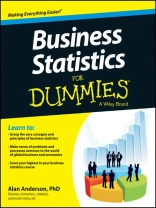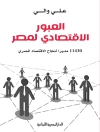Score higher in your business statistics course? Easy.
Business statistics is a common course for business majors and MBA candidates. It examines common data sets and the proper way to use such information when conducting research and producing informational reports such as profit and loss statements, customer satisfaction surveys, and peer comparisons.
Business Statistics For Dummies tracks to a typical business statistics course offered at the undergraduate and graduate levels and provides clear, practical explanations of business statistical ideas, techniques, formulas, and calculations, with lots of examples that shows you how these concepts apply to the world of global business and economics.
* Shows you how to use statistical data to get an informed and unbiased picture of the market
* Serves as an excellent supplement to classroom learning
* Helps you score your highest in your Business Statistics course
If you’re studying business at the university level or you’re a professional looking for a desk reference on this complicated topic, Business Statistics For Dummies has you covered.
Inhaltsverzeichnis
Introduction 1
Part I: Getting Started with Business Statistics 5
Chapter 1: The Art and Science of Business Statistics 7
Chapter 2: Pictures Tell the Story: Graphical Representations of Data 23
Chapter 3: Finding a Happy Medium: Identifying the Center of a Data Set 39
Chapter 4: Searching High and Low: Measuring Variation in a Data Set 55
Chapter 5: Measuring How Data Sets Are Related to Each Other 71
Part II: Probability Theory and Probability Distributions 91
Chapter 6: Probability Theory: Measuring the Likelihood of Events 93
Chapter 7: Probability Distributions and Random Variables 111
Chapter 8: The Binomial, Geometric, and Poisson Distributions 121
Chapter 9: The Uniform and Normal Distributions: So Many Possibilities! 139
Chapter 10: Sampling Techniques and Distributions 165
Part III: Drawing Conclusions from Samples 185
Chapter 11: Confidence Intervals and the Student’s t-Distribution 187
Chapter 12: Testing Hypotheses about the Population Mean 201
Chapter 13: Testing Hypotheses about Multiple Population Means 233
Chapter 14: Testing Hypotheses about the Population Mean 251
Part IV: More Advanced Techniques: Regression Analysis and Forecasting 281
Chapter 15: Simple Regression Analysis 283
Chapter 16: Multiple Regression Analysis: Two or More Independent Variables 309
Chapter 17: Forecasting Techniques: Looking into the Future 327
Part V: The Part of Tens 351
Chapter 18: Ten Common Errors That Arise in Statistical Analysis 353
Chapter 19: Ten Key Categories of Formulas for Business Statistics 361
Index 373
Über den Autor
Alan Anderson, Ph D is a teacher of finance, economics, statistics, and math at Fordham and Fairfield universities as well as at Manhattanville and Purchase colleges. Outside of the academic environment he has many years of experience working as an economist, risk manager, and fixed income analyst. Alan received his Ph D in economics from Fordham University, and an M.S. in financial engineering from Polytechnic University.












